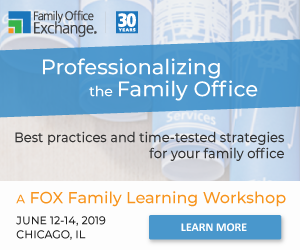The Essentials of Family Office Services

Tackling the 'One, Two, Threes'
Let’s never forget integrated services are the crucial deliverables by a family office and these services provide the best evidence to judge the performance of the office.
There are three key inputs related to services, (1) strategy and goals, (2) scope, and (3) execution, that again and again are cited as critical for success by family offices when serving clients. Call them the “one, two, threes” of family office services.
The three elements should be considered key building blocks for any services provided by the office or coordinated by the office through third party providers. Within services, they constitute best practice components.
Easy, right?
In our view, addressing strategy and goals, scope, and execution can be challenging without proper planning and commitment by all stakeholders. The stakeholders include the family itself, office staff, any governance structure, and third-party advisors.
The graphic below sets forth the three elements for optimizing services performed by the family office or coordinated through that same office:
Whether establishing services or reviewing existing services, family offices will benefit from thoughtful planning to incorporate all three components. We address each in turn.
1. Strategy and Goals for Family Office Services
If there is one big takeaway from this blog, it is that family offices typically fall short when they define current services by needs and do not start with strategy and goals. These include both family-wide strategy and goals as well as those at the individual or household level.
Long experience demonstrates that setting a strategy focused on a goals-based approach, and documenting those goals, is of the utmost importance for creating an effective scope of services. A goals-based approach makes it simpler to identify current and future service needs. Defining strategy and goals and corresponding services can enhance the alignment of the office and the family, to a greater degree than anything else.
As we think through the importance of defining goals, we examine first an obvious example and, second, a less obvious example.
First, understanding investment goals such as aggressive growth of assets will inform the degree of illiquidity, complexity, leverage, or concentration in a portfolio among other attributes. This will have consequences for service needs, including obvious ones like the sophistication of investment advice, risk management, communications, consolidated financial reporting and the underlying technology platform utilized.
Second, what if the family has the goal of promoting family engagement and continuity far into the future? Services will be needed today to educate, train, and develop leadership skills of next generation family members. Will there be a systematic program? How will the effectiveness of the services program be measured: At the end of each year? Over a multi-year or multi-decade time period?
Let’s incorporate some data into the discussion. FOX’s single family office survey at the end of 2017 indicated about one-third of family offices document goals at the individual and household level or family-wide.
If only a third of the families are focused on goals and strategies, what are the others missing?
Although it is challenging, a family working with its office staff and third-party advisors can connect services and goals. The broader the services and the larger the family, typically the more difficult the task. Only once the family’s strategy and goals are established should service scope and execution of services be finalized.
2. Scope of Family Office Services
The second component of a successful service program is defining the scope of services to be provided to clients of the office. The goals and needs of the family must be translated into a service menu. Defining what is on the menu is important.
We recommend a written service menu be issued by the office. The menu shows individual services, but also how integrated wealth management services will be harnessed to serve the family. The holy grail in any service plan is the integration of wealth management services, whether performed through the office or coordinated and performed by third-party advisors. All this permits an office to be proactive and gain clarity on what will be delivered and what is not to be provided to the family. There can, of course, be some variation in services provided in the family to different individuals, households, branches or generations.
A high-level menu of core, traditional office services offered through the family office follow:
- Financial reporting and accounting (including cost control)
- Cash management and budget / bill pay
- Tax preparation
- Estate planning
- Trusteeship
- Investment strategy and oversight
- Insurance
- Family meetings
- Philanthropy
The first three services listed above are foundational in nature and there are few offices that do not perform them even if they are outsourced to a degree. (They are the classic building blocks of a compliance family office, which is the most rudimentary family office.) Additional, less traditional and basic services can, of course, be offered depending on the goals and needs and the family. Such services could be focused on the cohesion and development of the family itself through the office’s support of education, entrepreneurship, governance, leadership, communications, or legacy.
Just as important as what is provided to the family is defining any services that are not provided. In particular, beware of special projects not explicitly offered that can consume time and resources and disrupt an overall service plan.
3. Execution of Family Office Services
Setting goals and strategy and defining the scope of services will be for naught without high-quality execution. Execution is vital and can have a great impact on the quality of the deliverables as well as client satisfaction and the client experience.
In our experience, all offices should consider two paramount considerations as regards service delivery: (1) optimizing integration of wealth management services for the family as a whole and at the individual or household level and (2) carefully determining reasons for insourcing vs. outsourcing (or a combination thereof) of each individual service − in other words which party(ies) delivers the service.
That said, providing services brings into play a slew of other considerations, many of which reflect on broader aspects of the office: Talent and organizational structure including skill sets available; process and procedures and compliance; costs of the office and compensation structures as well as total wealth management expenses; technology and data security; and measuring the performance of the value delivered, among others.
For example, let’s look at the link between delivery of services and talent.
In all instances, the office should view talent and organizational structure beyond the office staff. We often advise creating an organizational chart, all on one page, that includes office staff as well as third-party advisors and the connections between them. Offices don’t normally think as expansively and regularly consider all the resources third-party resources represent. On average, an office will be working with 27 different external advisors, including accountants, attorneys, trustees, various types of consultants, custodians, insurance providers, and asset managers. How the broader team works together is a key to success.
Our benchmarking of family offices finds, the leader of the office spends one-third of his or her time coordinating outside advisors. Rarely is that responsibility listed in a job description or the skill set highlighted when hiring. In any event, there is no doubt that the quality of the team and coordination between its individual parts will have a large impact on the delivery of services.
In sum, we think the one, two, threes of family office services - strategy and goals, scope, and execution – are critical to success when establishing or enhancing the offering of the office.

